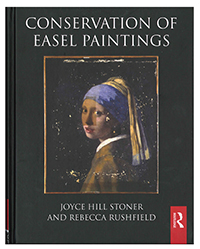Edited by Joyce Hill Stoner and Rebecca Rushfield
 After seven years of work and including essays by seventy-nine international author-experts, Conservation of Easel Paintings is now available from Taylor and Francis, amazon.com and barnesandnoble.com, etc. David Bomford, formerly Acting Director at the Getty Museum and currently Director of Conservation at the Museum of Fine Arts, Houston, writes in the foreword, “For the first time, we are looking at a coherent account of the entire history, philosophy, theory, and practice of the discipline [of painting conservation].” Bomford himself wrote the key chapter about history and philosophy of the cleaning of paintings, the most challenging procedure carried out by a conservator.
After seven years of work and including essays by seventy-nine international author-experts, Conservation of Easel Paintings is now available from Taylor and Francis, amazon.com and barnesandnoble.com, etc. David Bomford, formerly Acting Director at the Getty Museum and currently Director of Conservation at the Museum of Fine Arts, Houston, writes in the foreword, “For the first time, we are looking at a coherent account of the entire history, philosophy, theory, and practice of the discipline [of painting conservation].” Bomford himself wrote the key chapter about history and philosophy of the cleaning of paintings, the most challenging procedure carried out by a conservator.
The book, almost 900 pages long, provides a thorough history of Western easel painting materials, from wooden or canvas supports to varnishes; techniques used to examine paintings (including x-radiography, infra-red reflectography, optical microscopy, and cross-section analysis); methods and approaches for treatment, including consolidation, tear mending, lining, cleaning, retouching, and varnishing; and improved methods for transporting, storing, lighting, and framing paintings. Special sections address sustainable conservation management of exhibitions, emergency preparedness and recovery, attack by insect pests, and health and safety concerns in the studio.
Practicing artists may enjoy reading “Recommending Materials to Artists,” by Mark Gottsegen, author of the excellent up-to-date “bible” on artists’ materials: The Painter’s Handbook. Conservators have been working internationally to establish dialogues with living artists so that both the materials and the spiritual values of their works can be more sensitively preserved in the future. The International Network for the Conservation of Contemporary Art (INCCA or http://www.incca.org/ ) is described in a section on “Collecting and Archiving Information from Living Artists.” Respected expert on the composition and longevity of modern paints, Dr. Tom Learner of the Getty Conservation Institute, discusses the new paints that have appeared since 1940 and cleaning concerns for acrylic emulsion paints. He describes how the binding media of new paints helped to make possible the results achieved by Jackson Pollock, Morris Louis, Ma rk Rothko, Bridget Riley, and many others. Mark Golden has provided an essay on varnishing of acrylic paintings by artists.
Dr. Joyce Hill Stoner credits her co-editor, Rebecca Rushfield, with the extraordinary work compiling a comprehensive 100-page bibliography. Dr. Stoner herself has been teaching paintings conservation and collaborating with living artists for over thirty-five years. She identified and recruited key experts who have carried out significant research in artists’ interviews; historical gesso, grounds, and pigments; causes of deterioration of Old Master paint media; current sophisticated methods of examination and instrumental analysis; and new approaches and materials for the cleaning and retouching of paintings, etc.
This is a truly comprehensive book that presents a range of up-to-date information and can now form the basis for further development and discussion. It is now a crucial resource for training conservation students and will provide generations of interested artists, dealers, students of art and art history, curators, directors, collectors, and practicing paintings conservators with valuable information and guidance.
About Golden Artist Colors, Inc.
View all posts by Golden Artist Colors, Inc. -->Subscribe
Subscribe to the newsletter today!
No related Post
